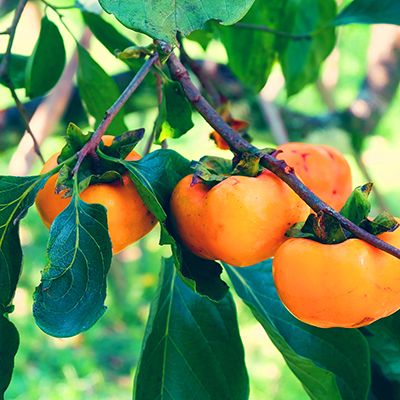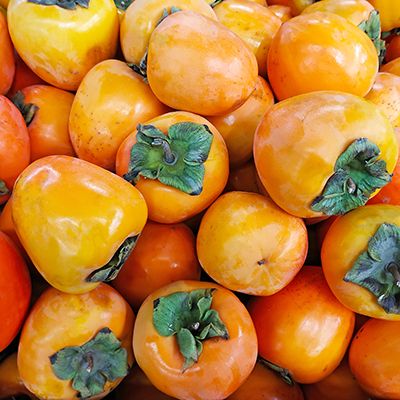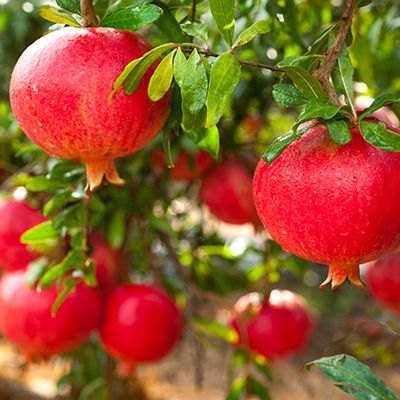


Persimmon and Pomegranate Trees
Persimmon and Pomegranate trees both have extremely handsome fruits in late Fall and early winter. After the leaves drop they resemble surreal Christmas trees decorated with bright orange-red ornaments. Their ancestry as cultivated fruit trees dates back more than 2000 years.
At maturity, a Persimmon tree (Diospyros kaki) can be up to 40 feet tall if unpruned and between 10 and 20 feet when pruned. It does not require a pollinizer and needs only 100 to 400 chilling hours, therefore will grow any place in the Bay Area when cultural requirements are favorable. These plants will grow satisfactorily in our alkaline, clay soils if the soil can be improved to allow favorable drainage. Some Persimmons have a long taproot and will require a deeper hole than normal if planted bare root. (See our Care Guides on Planting Bare Root Trees & Roses and Planting Trees and Shrubs). Fertilize with Master Nursery Fruit Tree and Vine Food once a year about Valentine’s Day. Persimmons are less susceptible to drought than other deciduous fruit trees but vegetative growth and fruit production will be better with adequate and regular irrigation which should be at the drip line of the tree and run long enough to penetrate 12 to 18 inches.
Because Persimmons are remarkably free from diseases and pests, they seldom need spraying. Occasionally a few mealy bugs will be found under the calyxes of the fruit but not enough to require spraying. A dormant spray in January usually prevents them. The only pruning required is to remove dead wood and to keep them at a comfortable size. Fruit is borne on current season’s growth so summer pruning is discouraged. The fruit is strongly attached to the tree and should be harvested by cutting the fruit stem with shears.
There are two types of Persimmon fruit: astringent and non-astringent. Astringent fruit is acid tasting and makes your mouth pucker unless fruit is soft-ripe. The two most popular of the astringent group are Hachiya and Chocolate. Both are large, up to 4 or more inches long and 2-1/2 to 3 inches across. Hachiya is the most popular variety and most commonly available in markets. Chocolate produces dark-fleshed fruit which must be fully soft-ripe before eating. Both ripen by the end of November.
Fuyu is the most popular non-astringent variety and may be eaten when they are firm-ripe, much like apples. Fuyus ripen by the end of October. The reddish-yellow fruit is sweet and mild. The fruit is smaller than Hachiya and about the size of a flattened tennis ball. If you have trouble remembering which is which then think "H" is Hachiya which is Heart-shaped and "F" is for Fuyu which is Flat.
Pomegranates (Punica granatum) are often planted as ornamentals but Wonderful is the best known fruiting variety. A mature tree may be up to 15 feet tall, does not require a pollinizer and needs only 150 chilling hours. They will grow well in a diversity of soils including those of the Bay Area. When established, they do not need much water or fertilizer. Irrigate once a month with a deep soaking down to 16 or 18 inches. Build a berm at the dripline of the tree and flood the area around the tree being sure not to have water accumulating around the tree trunk. Fertilize before watering once a year around Valentine’s Day using Master Nursery Fruit Tree and Vine Food.
Pomegranate fruit is harvested when it becomes fully colored. The fruit will split open if left on the tree and then deteriorates quickly. Fruit with no cuts or splits may be stored in a cool, dry place or refrigerator for several months.
Like Persimmons, Pomegranates are subject to very few pests or diseases and do not require a regular spraying schedule. During late December or any time in January, the tree may be trimmed of dead or crossing branches. Water sprouts or wayward branches should also be removed at this time.
Consider a Pomegranate tree for those problem areas under telephone and power lines where vertical space is limited. There are some Pomegranate trees which produce little or no fruit so this makes them candidates for that narrow useless space between the street and sidewalk under power lines.
Consider investing in a Rapitest Moisture Meter. Use it to ensure that water is reaching the rootlets at and beyond the dripline of your trees and shrubs during irrigation.